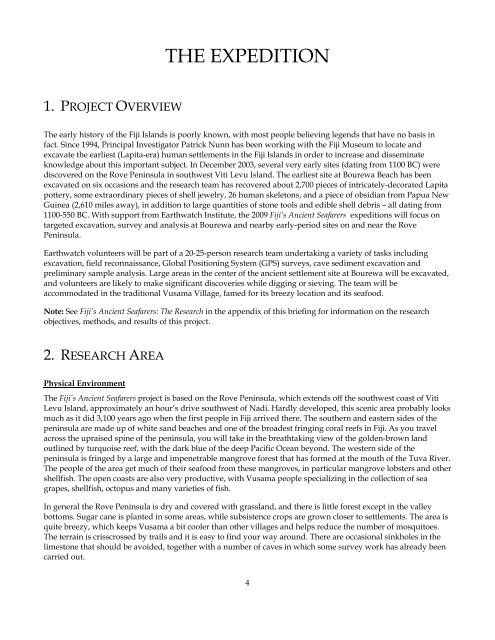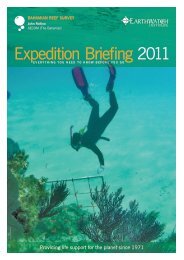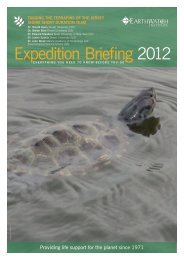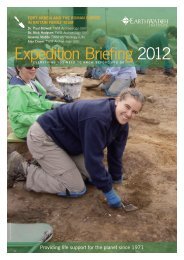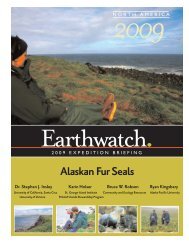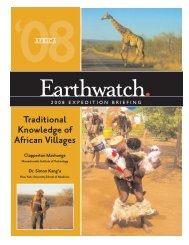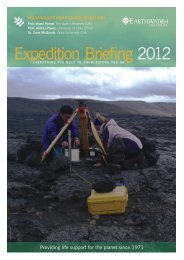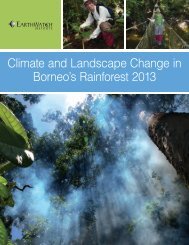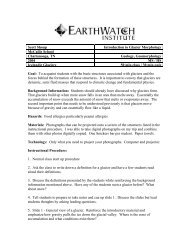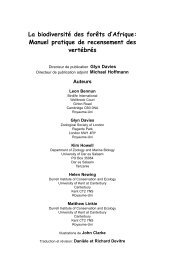Fiji's Ancient Seafarers Dr. Patrick D. Nunn - Earthwatch Institute
Fiji's Ancient Seafarers Dr. Patrick D. Nunn - Earthwatch Institute
Fiji's Ancient Seafarers Dr. Patrick D. Nunn - Earthwatch Institute
Create successful ePaper yourself
Turn your PDF publications into a flip-book with our unique Google optimized e-Paper software.
THE EXPEDITION<br />
1. PROJECT OVERVIEW<br />
The early history of the Fiji Islands is poorly known, with most people believing legends that have no basis in<br />
fact. Since 1994, Principal Investigator <strong>Patrick</strong> <strong>Nunn</strong> has been working with the Fiji Museum to locate and<br />
excavate the earliest (Lapita-era) human settlements in the Fiji Islands in order to increase and disseminate<br />
knowledge about this important subject. In December 2003, several very early sites (dating from 1100 BC) were<br />
discovered on the Rove Peninsula in southwest Viti Levu Island. The earliest site at Bourewa Beach has been<br />
excavated on six occasions and the research team has recovered about 2,700 pieces of intricately-decorated Lapita<br />
pottery, some extraordinary pieces of shell jewelry, 26 human skeletons, and a piece of obsidian from Papua New<br />
Guinea (2,610 miles away), in addition to large quantities of stone tools and edible shell debris – all dating from<br />
1100-550 BC. With support from <strong>Earthwatch</strong> <strong>Institute</strong>, the 2009 Fiji’s <strong>Ancient</strong> <strong>Seafarers</strong> expeditions will focus on<br />
targeted excavation, survey and analysis at Bourewa and nearby early-period sites on and near the Rove<br />
Peninsula.<br />
<strong>Earthwatch</strong> volunteers will be part of a 20-25-person research team undertaking a variety of tasks including<br />
excavation, field reconnaissance, Global Positioning System (GPS) surveys, cave sediment excavation and<br />
preliminary sample analysis. Large areas in the center of the ancient settlement site at Bourewa will be excavated,<br />
and volunteers are likely to make significant discoveries while digging or sieving. The team will be<br />
accommodated in the traditional Vusama Village, famed for its breezy location and its seafood.<br />
Note: See Fiji’s <strong>Ancient</strong> <strong>Seafarers</strong>: The Research in the appendix of this briefing for information on the research<br />
objectives, methods, and results of this project.<br />
2. RESEARCH AREA<br />
Physical Environment<br />
The Fiji’s <strong>Ancient</strong> <strong>Seafarers</strong> project is based on the Rove Peninsula, which extends off the southwest coast of Viti<br />
Levu Island, approximately an hour’s drive southwest of Nadi. Hardly developed, this scenic area probably looks<br />
much as it did 3,100 years ago when the first people in Fiji arrived there. The southern and eastern sides of the<br />
peninsula are made up of white sand beaches and one of the broadest fringing coral reefs in Fiji. As you travel<br />
across the upraised spine of the peninsula, you will take in the breathtaking view of the golden-brown land<br />
outlined by turquoise reef, with the dark blue of the deep Pacific Ocean beyond. The western side of the<br />
peninsula is fringed by a large and impenetrable mangrove forest that has formed at the mouth of the Tuva River.<br />
The people of the area get much of their seafood from these mangroves, in particular mangrove lobsters and other<br />
shellfish. The open coasts are also very productive, with Vusama people specializing in the collection of sea<br />
grapes, shellfish, octopus and many varieties of fish.<br />
In general the Rove Peninsula is dry and covered with grassland, and there is little forest except in the valley<br />
bottoms. Sugar cane is planted in some areas, while subsistence crops are grown closer to settlements. The area is<br />
quite breezy, which keeps Vusama a bit cooler than other villages and helps reduce the number of mosquitoes.<br />
The terrain is crisscrossed by trails and it is easy to find your way around. There are occasional sinkholes in the<br />
limestone that should be avoided, together with a number of caves in which some survey work has already been<br />
carried out.<br />
4


